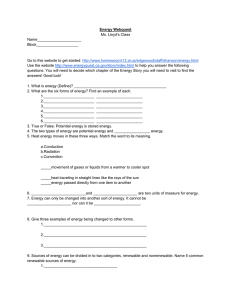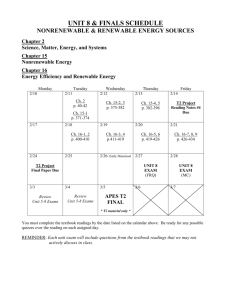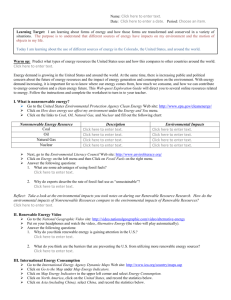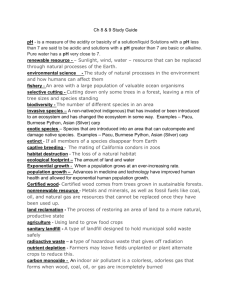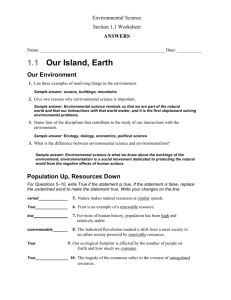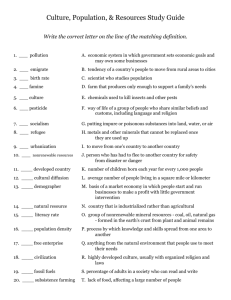How do Predator/Prey Interactions Affect an Ecosystem?
advertisement
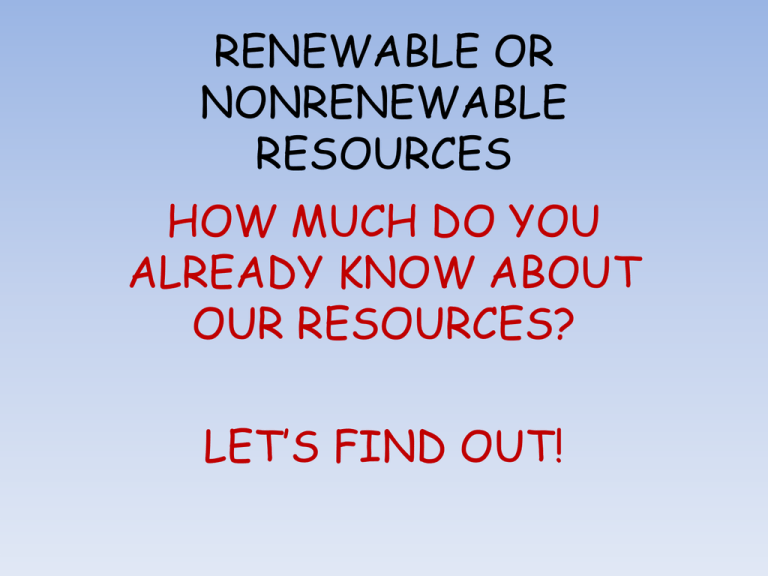
RENEWABLE OR NONRENEWABLE RESOURCES HOW MUCH DO YOU ALREADY KNOW ABOUT OUR RESOURCES? LET’S FIND OUT! RENEWABLE OR NONRENEWABLE RESOURCES Read each statement in your lab book. Mark your choice of true or false at the beginning of each statement. NATURAL RESOURCES Natural resources are the raw materials supplied by the earth and its processes and include things in the physical environment used for housing, clothing, heating, cooling, and transportation that meet other human wants and needs. NATURAL RESOURCES EXAMPLES: Trees are used for shelter. Animals for food and clothing. Plants for medicine. Minerals and fossil fuels for power, transportation, heating and cooling. NATURAL RESOURCES All these resources include soil, air, water, sunshine, forests, wildlife, fish, fossil fuels, metals and minerals produced by the earth’s natural processes. RENEWABLE OR NONRENEWABLE RESOURCES Resources such as trees, fish, oxygen, and fresh water are generally considered to be renewable resources because they can be renewed. Fresh air from the oxygen produced by plants, trees, and fish which can reproduce themselves are other examples. The kind of resources that can be replaced in a short time is called RENEWABLE NATURAL RESOURCES. RENEWABLE OR NONRENEWABLE RESOURCES The kind of natural resource that can be replaced only at a slow rate, or not at all is called a NONRENEWABLE NATURAL RESOURCE. Minerals and fossil fuels taken out of the earth like oil and gas are non-renewable natural resources. RENEWABLE can be defined as: “Capable of being replaced by natural ecological cycles or sound management practices.” LET’S CHECK OUR T/F ANSWERS 1. Natural resources such as air, water and sunlight come from nature. TRUE LET’S CHECK OUR T/F ANSWERS 2. Renewable resources are resources whose supplies never stop. TRUE LET’S CHECK OUR T/F ANSWERS 3. Humans only use renewable resources. FALSE ~ We use both. LET’S CHECK OUR T/F ANSWERS 4. Natural resources such as trees are nonrenewable resources. FALSE ~ Trees are renewable. LET’S CHECK OUR T/F ANSWERS 5. Nonrenewable resources are replaced only when made in factories. FALSE ~ Nonrenewable are not replaceable. LET’S CHECK OUR T/F ANSWERS 6. Earth’s natural resources will be used up in 25 years or less. FALSE ~ We will continue to research this in our next lesson. Factors that impact a resource’s ability to renew supplies: a. Fresh water’s renewal is threatened by: When fresh ground water gets used up and no rain falls, sometimes for years, more than ¾ of underground water is nonrenewable. (chemical spills, overuse, insufficient treatment plans) Factors that impact a resource’s ability to renew supplies: b. Trees’ renewal is threatened by: Deregulation, enforcement of existing laws, growth Factors that impact a resource’s ability to renew supplies: c. Oxygen and clean air renewal is threatened by: When forests and plants get destroyed from acids, they no longer produce oxygen. (pollution, growth) Factors that impact a resource’s ability to renew supplies: d. Land and soil renewal is threatened by: When land is over grazed or the nutrients in the soil is used up due to farming, the soil cannot renew itself. Mismanaged growth, erosion Factors that impact a resource’s ability to renew supplies: e. Habitat renewal is threatened by: Oil spills (Exxon), pollution, war, population growth Factors that impact a resource’s ability to renew supplies: f. Fish renewal is threatened by: Toxins kills aquatic life like fish, streams, rivers, lakes, and others. (pollution, nutrient run-off, erosion, growth)
